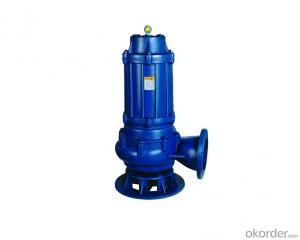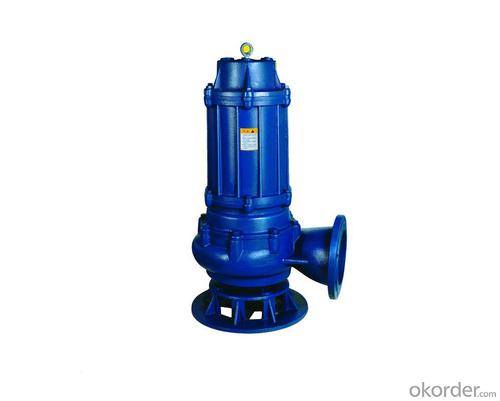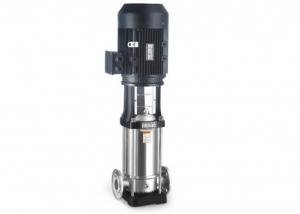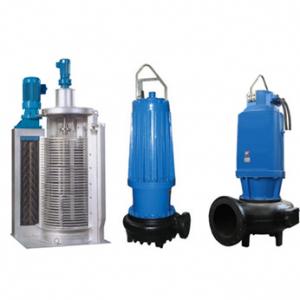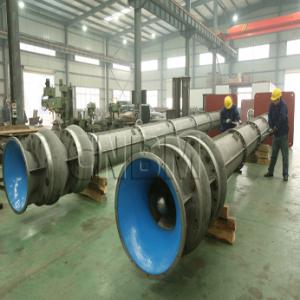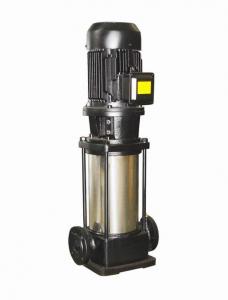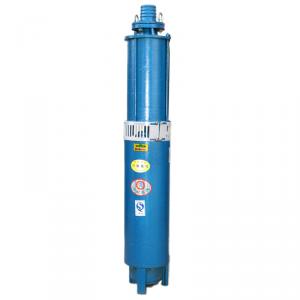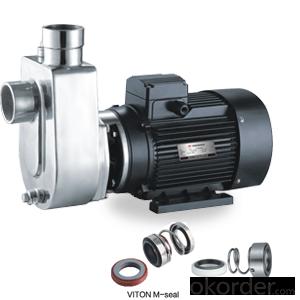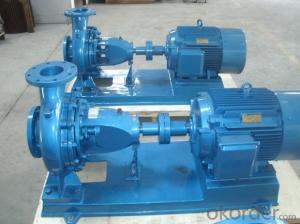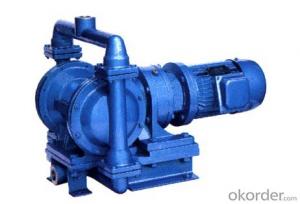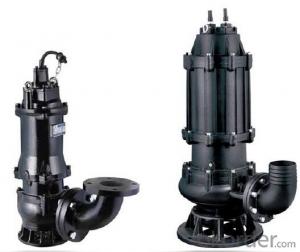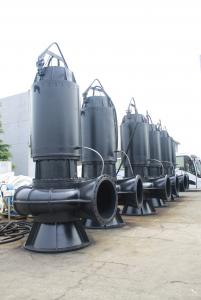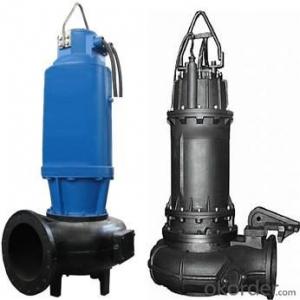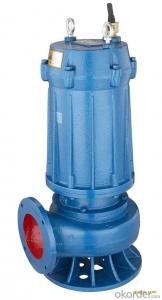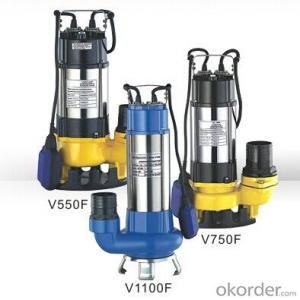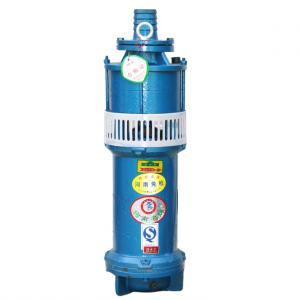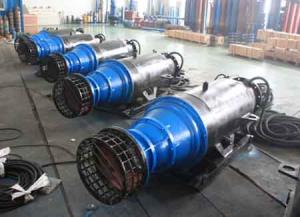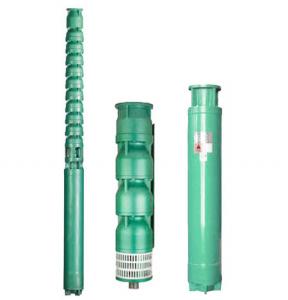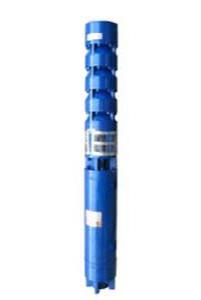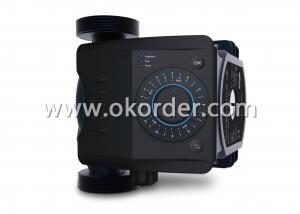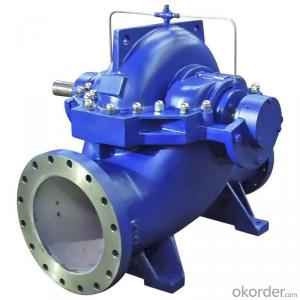Sewage Submersible Pump WQ Series
- Loading Port:
- China Main Port
- Payment Terms:
- TT OR LC
- Min Order Qty:
- -
- Supply Capability:
- -
OKorder Service Pledge
OKorder Financial Service
You Might Also Like
General Description
Type CRQW submersible sewage pump is newly developed on the basis of the advanced technology from international. Is used for industry and commerce, the living area,urban sewage treatment plant, waterworks,civil air-defense construction,hospital,hotel and so on. They can also be used in public works, explore, country methane, irrigation, deliver water with impurity. The flow-rate range of the delivery water is 7-10000m3/h, lift range is 7-60m,power range is 0.55-315KW, caliber range is φ25-φ700 mm.
Service conditions
* Medium temperature should not above 60℃, Maximum density is 1.3×103kg/m3.
* If the pump without a build-in self-circulation cooling system, its motor should not expose above water more than half.
* Deliver medium’s PH value is between 4 and 10.
* Solid particle passing capacity is 60% of the inlet diameter, the length of the fiber is 5 times to inlet diameter.
Instruction of pump type
Example: 100CRQW100-15-7.5
100 in the front: Pump outlet diameter is 100mm
CR: Company code, means produced by CREDO PUMP
QW: Submersible sewage pump
100 after: Flow capacity 100m3/h
15: Head is 15m
7.5: Motor power is 7.5KW
Structure
*Type CRQW Submersible Sewage Pump adopts particular single blade or double blade; advance the ability for get across feculence. Fiber about 5 times as pump caliber can across.
*Mechanical seal adopt fresh model cemented carbide rot-proof material, and at the same time, we improved on the airproof to the single-ended double-face mechanical seal, let them work in oil chamber for a long period of time.
*The whole structure is compact;, volume is small, little noise and the energy saving result was apparent. The machine needn’t pump room .It can work just dinning into water, so reduce project cost.
*According to need, we can equip safety protection control cupboard to protect the pump, advanced the safety and reliability.
*The float switch can control automatically, do not need specially-assigned person. It’s very convenient.
*According to need, we can equip automatic coupler installation system. So people needn’t get into the drainage ditch.
*Can be used in all the range of lift ,and it won’t overload.
*There are two different install way, fixed type automatic installation system and movable type automatic installation system.
- Q: i have a 1996 camaro rs v6 that needs a new water pump, the old one is leaking from a failsafe type hole.i know that im probably not gonna get one but its simply the perfect time to so if i am so... but should i consider getting an electric water pump instead of the $50 origional replacement? the car has no 'real' mods and i know the electric water pump would be a two horse difference, and that it is a mostly race type modification. so i had to ask because if i was to do this mod, now is the time. so what do you think? things like average cost of a good name like meziere , how hard to wire, etc.thanks
- Not sure where your shopping, but I could have sworn water pumps were more than that at least the ones I buy. And yes, I do not buy aftermarket parts since I do not like replacing the same part over over again every month!!!!!!! I would advise you if you do not want to replace the engine down the road for overheating, I would stick with factory water pump leave the electric pump idea alone!!!!! Last time I checked on those, they were more than $50.00 also.
- Q: i used my water fountain pump for the first time yesterday and I've had it for 10 years and i used it yesterday it worked with the water and everything was fine!then the next day i wanted to turn it on , it went on it started vibrating but it wasn't pumpingwhen i had it on the other day the water was dirty but it was workingi cleaned it the filtershould i put vinegar to clean it ?and what else should i do!??? Help :#92;thank you!
- This Site Might Help You. RE: my water fountain pump is not working !? i used my water fountain pump for the first time yesterday and I've had it for 10 years and i used it yesterday it worked with the water and everything was fine! then the next day i wanted to turn it on , it went on it started vibrating but it wasn't pumping when i had it on the other...
- Q: A total of three units, usually starting two units. After jumping the gate, it was like this. I haven't paid attention before. Is it a turn around?
- The water pump with frequency conversion is set correctly and will not burn the motor. If there is a problem, the frequency converter will automatically stop running. The frequency converter can change the positive and negative (frequency changer without this function, change the phase sequence)
- Q: This was asked a year ago, so just wanted to see if there were any new answers for me. And any detail of how it can be a quot;do it yourselffix would be great. We are having major surge lately and the tanks pressure gauge reads 50 if that helps. Thanks!
- I take it you live in the country. This happens to me all the time. My problem is caused by fire ants, I'm in tx. Those stupid things are attracted to the electricity for some reason and will swarm on the pressure switch and cause it to burn up or malfunction. Go look and see if you have any bugs on yours. If not, well then i dont know. Replace the switch and that will cure it. It is not hard, i have done it myself many times.
- Q: 2 pumps in parallel, lift the same, the pump head is not stacked; 2 pumps in series, the same flow, pump head is not superimposed?.
- 2 pumps parallel, lift the same, pump head is not stacked?;Answer: the head can not be superimposed, that is, a lift and a pump, but the pumping speed (flow) is two times a taiwan.2 pumps in series, the same flow, pump head is not stacked?.Answer: the head can be superimposed, that is, the pump head is two times as much as a pump, but the pump speed is the same as that of a pump.
- Q: We have fresh running water..no well... We just want to install it on our playground for the kids to experience a manual water pump. Can it be attached to running water? Do I need a tank? Help! Thank YOU!
- Go okorder before you do anything serious or the local health department. This could be opening up a whole new avenue of new lawsuits and illnesses to you and those around you, check first. My daughter drank some water out of a free flowing well, well she was plowing a field recently, she contracted a parasite that almost killed here, one that only comes from birds that drops it's feces while drinking at a water supply. Some states require drinking water to have a cement barrier 18 inches thick and three feet wide around it. Sorry.
- Q: I have a 1990 js550 that i picked up for a project. When in the water it overheats and minimal water comes out the tell tail. When on the tap it runs fine no overheating, so i disconnected the hose from the back of the ski where it sucks the water in and ran a garden hose directly to it. And the ski ran fine.I also cleaned all the tubes out with air.I am not getting enough water flow through the ski when it is in the water. Is there a water pump inside the motor?There is definitely no blockages, there is just no enough pressure to keep it cool.Thanks
- Hey Sam, It's Jeff again. I used to own a stand-up ski a while back, and I had the same problem. The water to the motor comes from the jet pump, the more RPM, the more pressure, There should be enough pressure to keep the motor cool at low RPM, but if not then there are a couple of things to check. Since you already eliminated a blockage in the motor buy disconnecting the pickup, first check the actual pickup for a restriction from the entrance to the connection you took the hose off at. If that's OK, then the clearance in the jet pump itself could be excessive. A ski with a lot of hours in sandy water can have pump wear that isn't really noticeable when cruising, you might notice it a little under heavy acceleration when leaving the no wake zone. Under idle there just isn't enough pressure to cool the motor. You can have it fixed for not to much, a little hard to do yourself. To save a planned day on the lake you can always get a cheep inline electric water pump. My last thought though, since your other question was about a slow cranking starter, I'd pull the plugs and spin it over to see if it spits water out the cylinders. It doesn't hurt just to eliminate a blown head gasket. As a side note, I like them a lot better then the big sit-down style, they're much more free then the bigger ones. It's like the difference between a motorcycle and a car. If you want to do the stuff the bigger ones do, buy a boat.
- Q: Even when all water is shut off in the camper, my water pump keeps running. Even when the tank is completely empty. Does anyone know what is causing this?
- The pump is pressure regulated and kicks on when pressure in the water storage tank drops, such as it does when you open a water faucet. Either the pressure regulator is defective or you have a leak in the plumbing. Somewhere there is an electric switch where you can turn the pump off manually, either on the pump or near the pump. I suggest you shut it off until you can determine what the problem is.
- Q: WHERE IS THE WATER PUMP LOCATED ON A 1995 HONDA CIVIC
- on the engine, in the front
- Q: It hasnt rain in quite a while, but I havent had any problems with the water or pressure, but it seems like the pump is always quot;onquot;. I purchased this house almost a year ago, never had a well, so I now very little about it. I moved in December, rain season here in NC, and remember the pump going on and off, now its constantly running, Is it normal for the pump to be running that much? any websites to read up on how a water well works?thanks
- Sounds like you have a holding tank problem. Check to see if it is leaking air. Or you could have a busted pipe somewhere, you could cut the water off in the house but not at the pump to see if it continues. If so the problem is at the well, if the problem stops after the tank refills you have a busted pipe between the pump and the house.
Send your message to us
Sewage Submersible Pump WQ Series
- Loading Port:
- China Main Port
- Payment Terms:
- TT OR LC
- Min Order Qty:
- -
- Supply Capability:
- -
OKorder Service Pledge
OKorder Financial Service
Similar products
Hot products
Hot Searches
Related keywords
